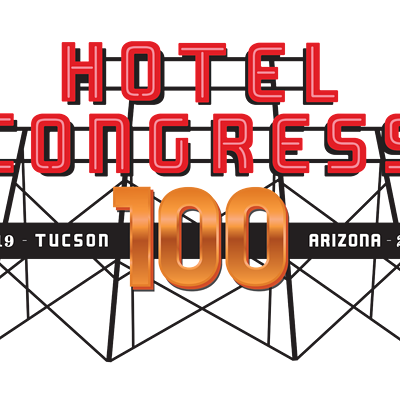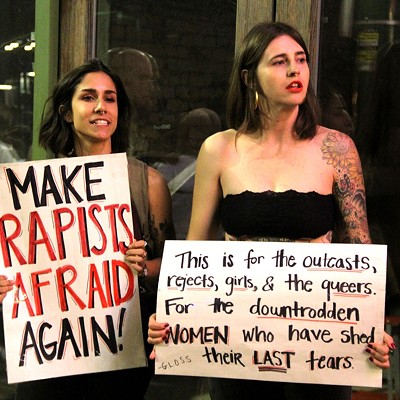Rising next to St. Augustine Cathedral like a bedraggled stepchild, the pummeled and patched Marist College is literally at a crossroads.
To the north lie the dissipated dreams of Rio Nuevo; to the south spreads the barrio, slowly crumbling from what residents believe—and the city denies—are ancient and leaky water pipes. To the west stands that bland residue of urban renewal called the Tucson Convention Center.
But amid all of this piety and imperfection, and even draped in undignified tarps to protect its naked adobe, Marist remains a potent symbol of what could be.
Or not.
To the many fans of Marist College, Tucson may be nearing the last, best chance to save this remarkable old building from the wrecking ball.
Opportunity rests with the efforts of an ad hoc group of preservationists, city officials, downtown boosters and, hopefully, visionary investors. Even the Roman Catholic Diocese of Tucson has given its nod to rescuing Arizona's sole surviving three-story adobe, erected in 1915 by master builder Manuel Flores, and resplendent in its flourishes of Italian renaissance and Spanish Colonial Revival styles.
The college also bears social significance. It was long operated by the Marist Brothers, a Catholic religious order founded by French priest Marcellin Champagnat in 1817. The order's original calling was to educate the impoverished children of France, a progressive mission that was eventually carried worldwide. That's reflected in the fact that Marist College was integrated, at a time when most Tucson schools were anything but.
"It was a day school and a boarding school," preservation activist Jennifer Levstik told the Tucson Weekly in an earlier interview. (See "History Resurrected," Currents, Oct. 1, 2009.) "So African Americans, Mexican Americans and some Anglo students—they all lived together and went to school together. Your economic background or your religious affiliation didn't really matter."
Today, Marist's advocates see the potential for a boutique hotel, perhaps with a tony restaurant in the basement. Among the biggest cheerleaders for private investment in the Marist is Michael Keith, CEO of the Downtown Tucson Partnership. Keith says Marist supporters are looking for "the highest and best use from a tax-return point of view."
And they may be on the verge of success, in what Keith calls a "very productive process" by a group that's "extremely motivated to find a solution for that, and make (Marist) one the jewels of downtown. It's an extraordinary building inside."
Within this complex funding chemistry, Keith says one thing is certain: private investment will be important to restoration costs that others have pegged at $3 million to $4 million. "You have to identify a broad range of funding sources," he says, "and then see if it still remains market-viable. But I think this is going to have a very happy ending."
These austere times mean slim public funding. Consider that last year, the college was nominated for a spot on the National Register of Historic Places—a designation opening the door to federal grants under the Save America's Treasures program. But that opportunity evaporated when Congress de-funded the program in this year's budget.
Still, the pending designation does offer the chance to tap federal tax credits for up to 20 percent of a developer's reconstruction costs, says Jonathan Mabry, the city's historic preservation officer.
Like others working to save the Marist, Mabry is keeping his fingers crossed. "I'm hopeful," he says. "I think this is one of the last chances to save this building."
Still, that "last chance" is playing awfully close to the wire. While Mabry says the college isn't at risk of collapsing, it is vulnerable to the vagaries of nature, such as heavy rains or micro-bursts. Such calamities aside, "the long-term prognosis for the building is good," he says.
Meanwhile, the building endures in melancholy disrepair. The last student left in 1968, and for the next 34 years, it served as Tucson Diocese offices. Subsequent neglect—including clogged roof scuppers that allowed water to collect, and the addition of stucco, which disastrously held moisture inside the unfired adobe—led to one corner collapsing after a heavy rain. Today, both western corners are damaged.
Simply halting further deterioration has cost tens of thousands of dollars, plucked in emergencies from various state and federal grants. The Diocese has also been generous, including providing $40,000 when those corners crumbled in 2005. "In every case, the Diocese has matched when the city obtained grants to apply to the building," says Mabry.
Diocese officials didn't return a phone call seeking comment.
With all of this in play, it's hard to look beyond the walls of Marist College, on this faded corner of Ochoa Street and Church Avenue. But to Demion Clinco, president of the Tucson Historic Preservation Foundation, the Marist is a transformative linchpin.
"It's architecturally significant and culturally significant," he says. "It's an anchor of downtown, especially on the southwest quadrant of downtown. I think its restoration could really act as a catalyst for that whole area."
Or for the entire city. "Having an iconic building like Marist College that becomes part of the public consciousness—and becomes something that we can celebrate as a community—could trigger other things," he says.
Including investment. Like Keith, Clinco argues that private money is key, not only to saving Marist College, but also to revitalizing this pocket of downtown. "It is absolutely 100 percent critical," he says, "that a private investor and developer would come to the table. I hope it can be a model for moving forward."
Local preservation crusader Ken Scoville has certainly seen plenty of models that don't result in preservation. But as part of the team fighting for Marist, he suggests this time might be different. Part of his optimism lies in the current popularity of locating businesses in historic buildings. And few are more historic or iconic than Marist.
"If you look at downtown now," he says, "especially with restaurants, everybody's looking for a historic space, where three or four years ago, I don't think historic buildings were quite in as much demand."
The Marist support team will act accordingly. "We're going to put out a 'request for interest' in the next month, to see whether people want a boutique hotel or classroom space or a restaurant in the basement, and all those kinds of things," Scoville says.
And with so few historic buildings still around, the market value of Marist College may be edging ever closer to that financial sweet spot called salvation.












